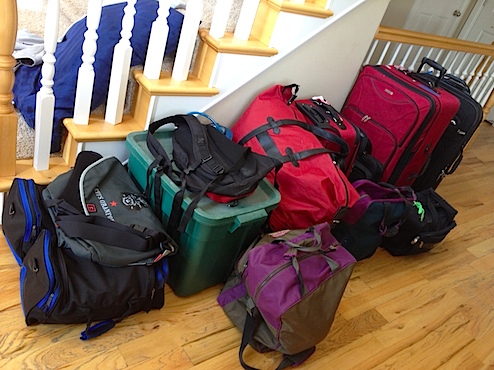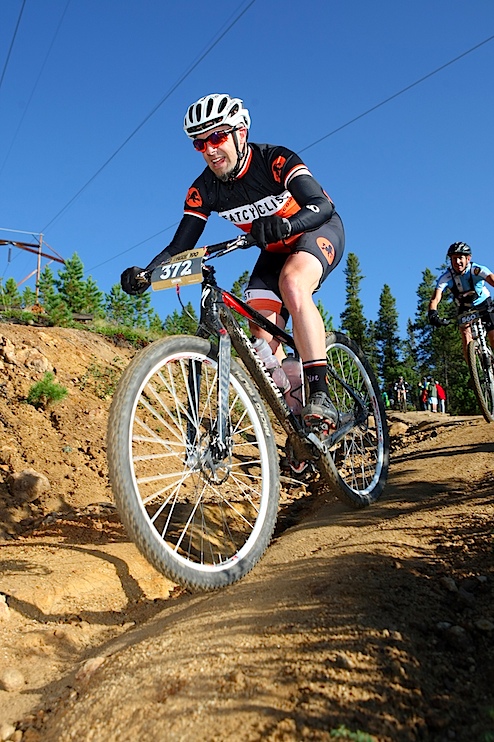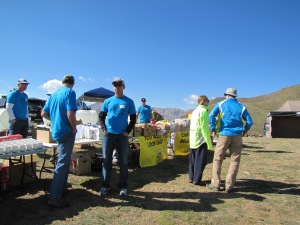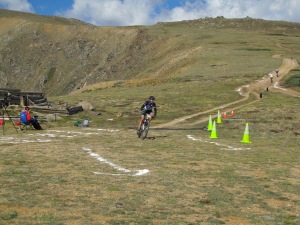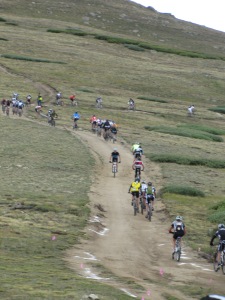Race Report: 2012 Leadville 100, Part 1
Here’s a paradox to get your week started off: It’s easier to pack for seven days of racing than it is for one. You don’t have to ponder which shorts to bring — bring ‘em all. You don’t have to consider which of your three favorite jerseys you should bring, because you know you’ll wear all of them. Should you pack for warm weather, cold weather, rain, or snow? Yes! Which Camelbak? All of them!
And that’s how we wound up with enough luggage to completely fill up a truck:
Bear in mind that all this doesn’t include the four bikes we brought (My Specialized Stumpjumper S-Works, Stumpjumper Single Speed [now geared at 34 x 20, in a last minute decision], and Trek Superfly 100, and The Hammer’s Gary Fisher Superfly), nor the ice chests we brought, nor the two plastic bins full of bike tools and dry goods.
Oh, and then about fifteen miles down the road we remembered: the canopy tent for our crew to use at Leadville.
Strangely, neither The Hammer nor I were particularly bothered that we had to turn around and go get this crucial item. Hey, we’d only lost half an hour, and now we knew what it was we had forgotten (because you have to forget something, right?).
Pre-Race Jitters x 7
The Hammer and I first drove to Breckenridge, scoping out where we’d be driving to as soon as the Leadville race ended, locating the starting line was for the first stage of the Breck Epic, and pre-registering at the condo where we’d be staying.
This was all very sensible and smart and so forth, but it also had the effect of giving us the “What Have We Gotten Ourselves Into?” terrors that much sooner.
Seven days of high-altitude endurance mountain bike racing? Really? What could make anyone think that’s a good idea?
The bad news is, that was pretty much the main thought that went through my mind up until the Leadville race began. The good news is, this new obsession kept me from getting as wound up about the Leadville race as I usually do (although Zac and Erin — our awesome crew for the LT100 — will attest that we were nevertheless plenty wound up).
The Race Begins
The morning of the race, I discovered something new: the time-honored tradition of going to the starting line early and laying down your bike to hold your place while you went and got breakfast, got dressed, etc., was over. The only way for you to hold your place in your corral was to get in there with your bike.
And — thanks to my traditional pre-race need to poop about twenty times — I was late to the “Silver” corral, which I got to be in thanks to my 8:18 finishing time last year. There was no room in that corral. It was jam-packed.
But there was Kenny in there. I could see him through the sea of people. I gave him a “Whatcha gonna do?” shrug.
“Surf your bike over to me!” he shouted.
“Cool,” I thought. “Like a MTB mosh pit.”
I hoisted all seventeen pounds of my bike over my head and passed it to the crowd. To my delight and astonishment, everyone was very cool about this technique and gladly sent the bike on its way toward Kenny. I wormed my way into the crowd, weaving among the tight mesh of wheels, cranks and people.
I was in place. Only about thirty feet back from the start. Primo spot. Fifteen minutes to start time. Kenny and I agree that if we can, we’ll work together. I love this idea, but — as many times as I’ve wanted to do it — it’s never worked out at Leadville. People tend to have to work with strangers; you just don’t know who will feel strong, or when.
Ten minutes. Then five. And then the gun.
Kenny was gone off my front immediately. I had no idea how he could go so fast on pavement on a singlespeed. His new training regimen — the first time he’s ever used a coach and a formal training plan, as far as I know — must’ve really worked.
Good for him. All I wanted was to get under nine hours on a singlespeed.
But while I felt as strong as last year, and had trained almost identically — lots of riding with The Hammer, essentially — I was also about seven pounds heavier than last year. And extra blubber is not your friend when you’re hauling it up the mountain.
Too Hard? Too Soon?
The first few miles of the Leadville 100 is downhill, on pavement. Which means I was disadvantaged in a comical number of ways. I shall enumerate:
- I was on a fat-tired singlespeed, which is about the slowest thing you can ride on downhill pavement and still be on wheels
- I was spooked, having been crashed on this section once before (I’m not even going to link to that event, due to superstition)
- I am not a fast downhiller, no matter what. (This truth will come into play a couple more times in this story)
And in short, I was passed — quite literally — hundreds of times before I got to the dirt. I didn’t care, though. I was staying upright. I was conserving my energy. And I was kind of wishing I had ridden a bike with just a few more parts — the parts that shift.
Then we took a right onto the dirt road and the “neutral start” was over. The race had begun for reals.
So why, all of a sudden, were all these people who had gone to such lengths to get ahead of me a few minutes ago on downhill pavement, now lollygagging?
I made an impromptu motivational speech.
“OK, all you people who shouted “on your left” at me a few minutes ago, get moving!” I shouted.
Which had no effect whatsoever.
Shocking.
So I got to work: sometimes finding the good passing line. Sometimes asking for the good line, just for a moment (astonishingly, racers almost always complied). Sometimes, when there was no other way, taking the bad line.
We were on St. Kevins now. The first climb of the day. And a great place to pass some folks in the race.
Here’s why.
There’s a lot of mystique about climbing St. Kevins in The Leadville 100. They say it’s going to hurt. They say it goes on forever. They say that if you take it too hard, you can burn all your matches on it, leaving you with nothing for the remaining 90+ miles of the race.
But the truth is, St. Kevins is a singlespeeder’s delight. It has a moderate grade with only the occasional steep pitch. If you can keep your momentum up and your eyes forward, plotting the next pass, you can get up to the hard left that signals a break from hard climbing in an amazingly short period of time.
Which is what I did.
And in fact, about two-thirds of the way up this climb, I caught up with Kenny. Which caused the little “angel and devil sitting on your shoulder” guys to appear.
“Hey, you’ve caught Kenny!” the little devil said.
“Which means you’re going too hard, too soon!” the little angel warned.
“Or that maybe Kenny’s going too slow,” the little devil countered.
“Pffff,” scoffed the little angel.
“Hey Mister Jones, ride with me,” I shouted.
“Sorry Fatty, gotta stay in zone 3″ Kenny replied.
At which point my head spun around and I looked around wildly for other signs that I had been, in fact, transported to Bizarro World, where Fatty rides fast on a singlespeed, ignoring numbers and listening to his legs, while Kenny wears an HR monitor and stays in zone 3.
The sharp left turn on St Kevins (you know what I’m talking about if you’ve ridden the LT100) arrived much more quickly than I expected it — not that I had a time goal for it; I didn’t. It just felt like the climb was a little . . . shorter than most years.
I figured that was a good sign.
I rode as fast as I could for the next couple miles, letting my legs burn a little, because I knew I had a 4.7-mile, mostly-downhill pavement rest coming up.
At her traditional spot, signaling an upcoming sharp turn, was Merilee, one of the founders of the race. As is my tradition, I shouted, “I love you, Merilee!”
As is her tradition, she laughs, self-consciously.
The Best Part of The Race Nobody Ever Even Thinks About
The three-or-so miles of pavement descending — which is where I crashed out in 2009 and have wondered ever since how I possibly crashed out on such a mild road — leads to a one-point-something mile climb on pavement, a hairpin turn, and then a couple miles of mild climbing on a washboarded road.
And then the Sugar Loaf climb.
Sugar Loaf is — for no good reason at all — hardly ever talked about in the Leadville 100 race. Maybe that’s because what comes after it (the Powerline Descent) is such a hairy experience that people forget Sugar Loaf.
Poor Sugar Loaf.
Here’s the thing, though. The climb up Sugar Loaf may in fact be the single best part of the Leadville 100 race. You’re not really tired yet; you’ve ridden less than twenty miles. It’s a challenging — but not really challenging — and beautiful stretch of trail. And it’s plenty wide enough to either pass riders or let riders pass you, depending on how things are going.
It’s also just about perfect for a singlespeed. At least, it felt perfect at the moment. I felt good, the sun was out, the air was cool — but no longer cold — and I was doing this stretch for the fifteenth time in my life.
That’s a lot of times.
The March of Progress
The top of Sugar Loaf leads to one of the two parts of Leadville 100 I always think to myself, “OK, just get through this.” It’s the Powerline descent.
This is the section where, if you’re going to crash out, you’ll probably crash out. This is the section where, if you’re going to get a flat, you’ll probably get that flat. Every year as I descend I count the people on the side of the trail, fixing their tires or dusting themselves off (or waiting for help).
This year, there were none — no crashes, no flats. At least when I went by.
That’s new.
Later, after the race, I told The Hammer about this surprising lack of carnage and we agreed: at least part of it is because wheel and tire technology has improved so much over the past few years. When I first started racing the Leadville 100, it was common to inflate tires to 50psi, to keep them from going flat (which also made them very hard and skittish). Now we use tubeless tires and low pressure (I run my tires at 22psi at Leadville, and run The Hammer’s at 20psi), giving us better control and fewer flats.
As for the fewer crashes, I think the lower tire pressure combined with the bigger wheels makes a huge difference.
Of course, the bigger wheels look bigger, too:
Wow. Those are some nice quads. Although I’m afraid it’s also pretty clear that I didnt exactly hit my weight goal before the race.
In any case, I got down the Powerline descent without having any problems — or seeing anyone having any problems — and noted the distance of the climb for when I had to come back up this monster of a climb later in the day.
Watching the Trains Go By
Once down from the Powerline, the Leadville 100 gives you a few minutes and miles to spin your legs on a combination of flat pavement and flat dirt road. This is a great place to form a group of riders and put some fast miles away.
Unless you’re on a singlespeed.
If you’re on a singlespeed, this section of the road is a great place to watch all the people you’d passed in the climbs ride by you as if you were standing still. I don’t even know how many people helpfully called out “jump on the train!” as they went by. I’d just laugh and wave. A singlespeed is just geared too low to stay with a geared bike on flats. It was time for me to patiently spin a sensible cadence and wait for the road to turn into anything but flat again.
I kept looking over my shoulder, expecting to see Kenny, so we could work together. But he was nowhere to be found.
However, another singlespeeder did come by me during this part — the first other singlespeeder I’d seen since I’d passed Kenny early in the race. “Sucks not to have gears on this part,” he said, as he went by.
Mentally agreeing, I tried to accelerate enough to catch him; maybe he and I could work together on this part. But he was too fast; after a minute I had to admit that I’d have to let him go.
I hit the first aid station — which I never stop at, because I’ve only been going 25 miles or so and don’t yet need a rest — in 2:02. Not at all bad — that sub-nine-hour race was looking possible.
But far from inevitable.
Yo Yo
The fifteen mile dirt road between the first and second aid stations is over before you know it. Fifteen miles or so. Quick climb, quick descent.
Thanks to the fact that I was on a singlespeed, though, I kept getting passed by people on those quick descents.
And then I’d pass them on the next little climb.
“See you in a minute,” became the little joke I’d tell people, either way.
OK, so it’s a very little joke.
I pulled into the second aid station about 2:50 into the race. I was slipping off the pace I wanted just a little, but nothing to get panicked about.
Scott (The Hammer’s brother), Zac (The Hammer’s eldest son), and Erin (Zac’s wife) were crewing for The Hammer, The IT Guy, Kenny, Heather, and me (although we all knew that they were all there mostly to see how The IT Guy fared in his first LT100). And they were awesome.
I pulled up at the canopy tent we had set up (definitely worth turning around for) and within twenty seconds they had done all of the following:
- Switched my bottles
- Pulled off my arm warmers
- Given me a cup of water to drink
- Given me a cup of soup (chicken and stars, as always) to drink
- Given me my food for the next stage of the race: four Honey Stinger Organic Energy Gels
The centerpiece of the race — the climb up and descent down the Columbine Mine road — was up next.
I had high hopes it would go well for me, and had no idea how much pain was in store.
Click here to continue on to part 2.

